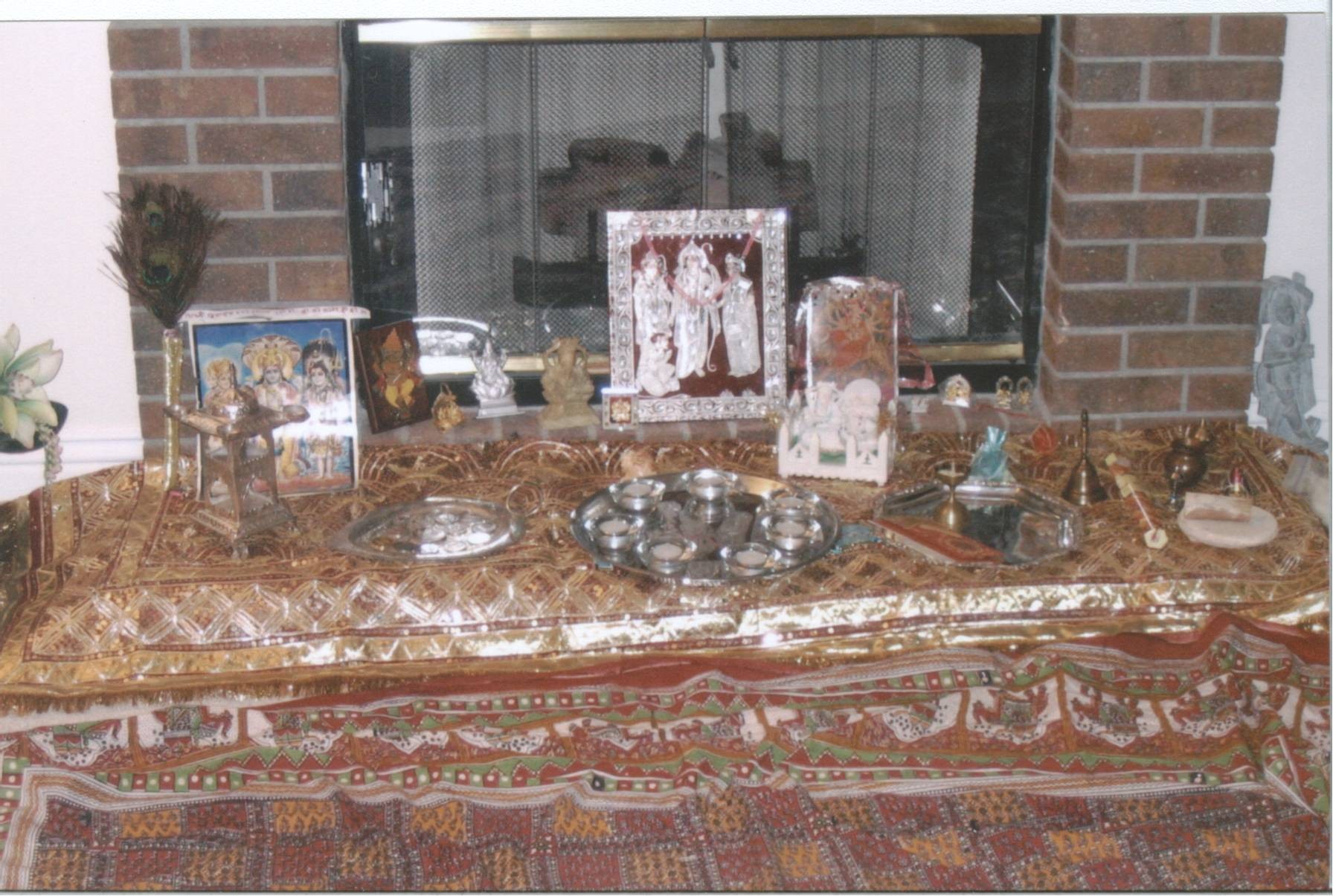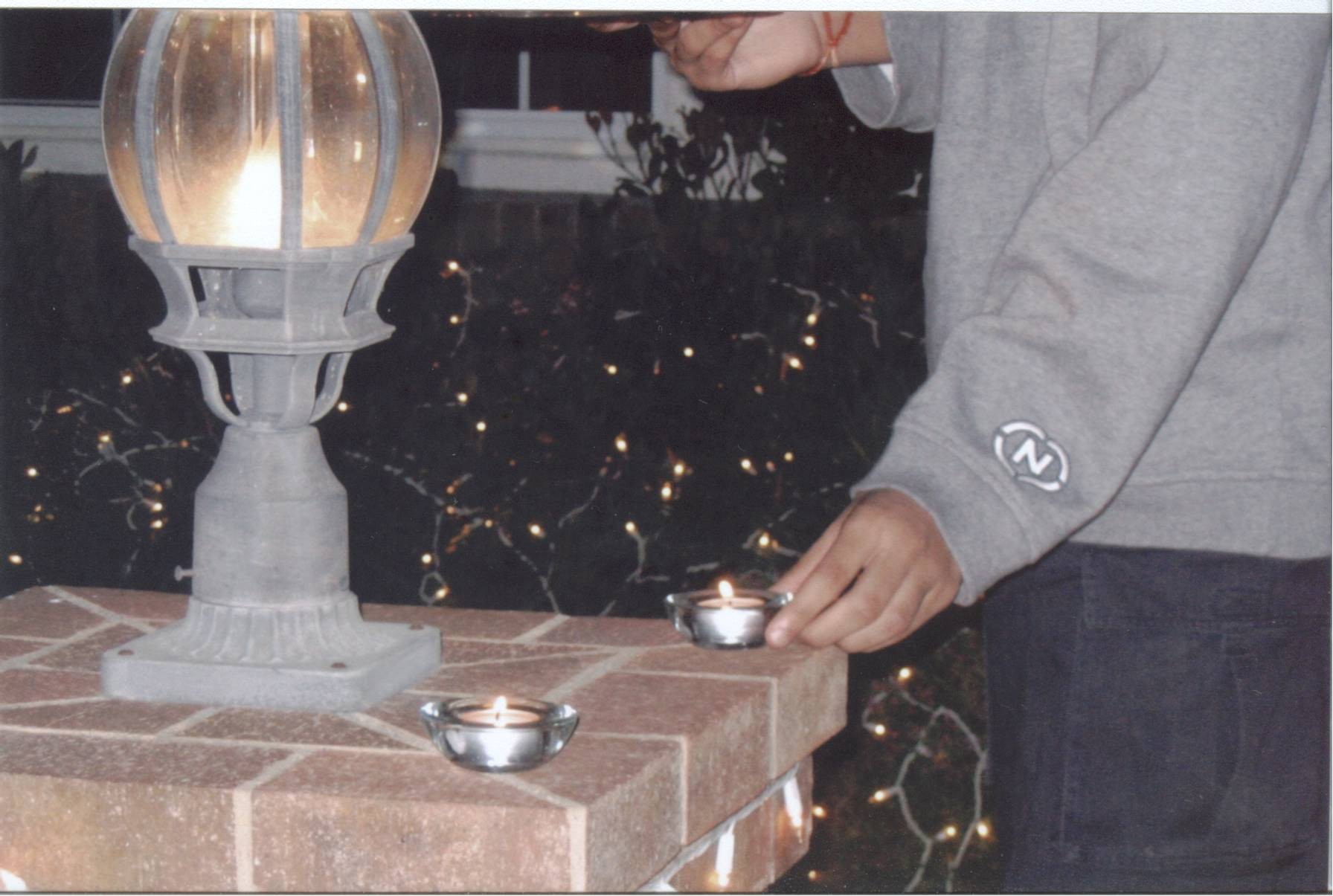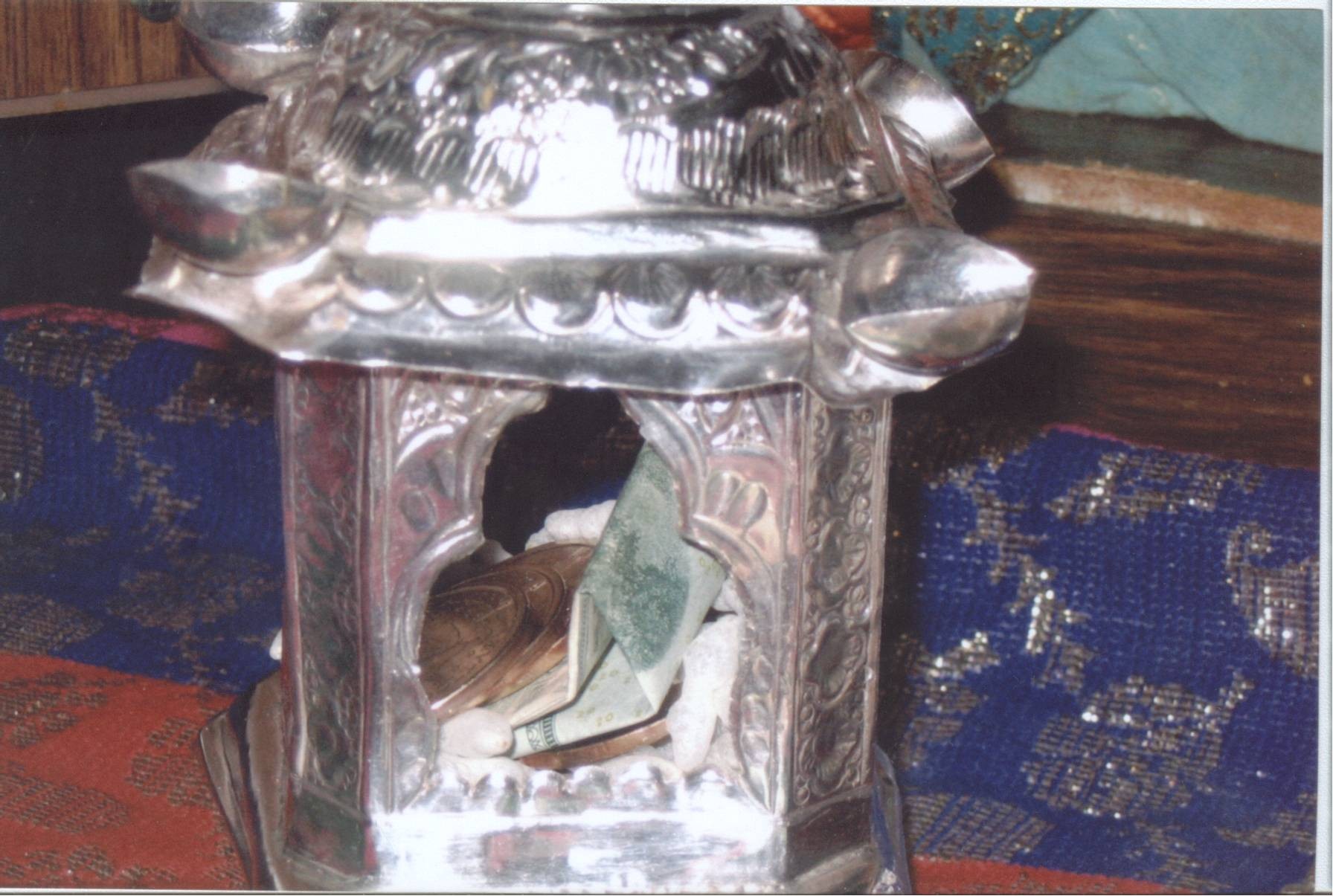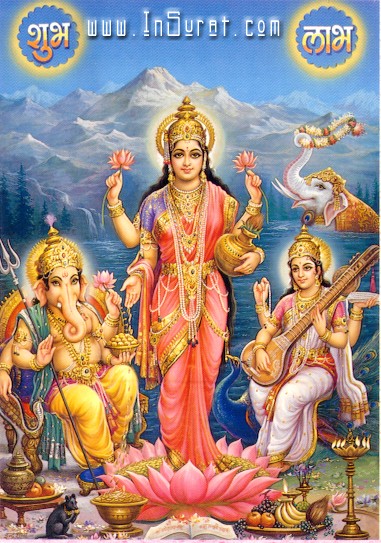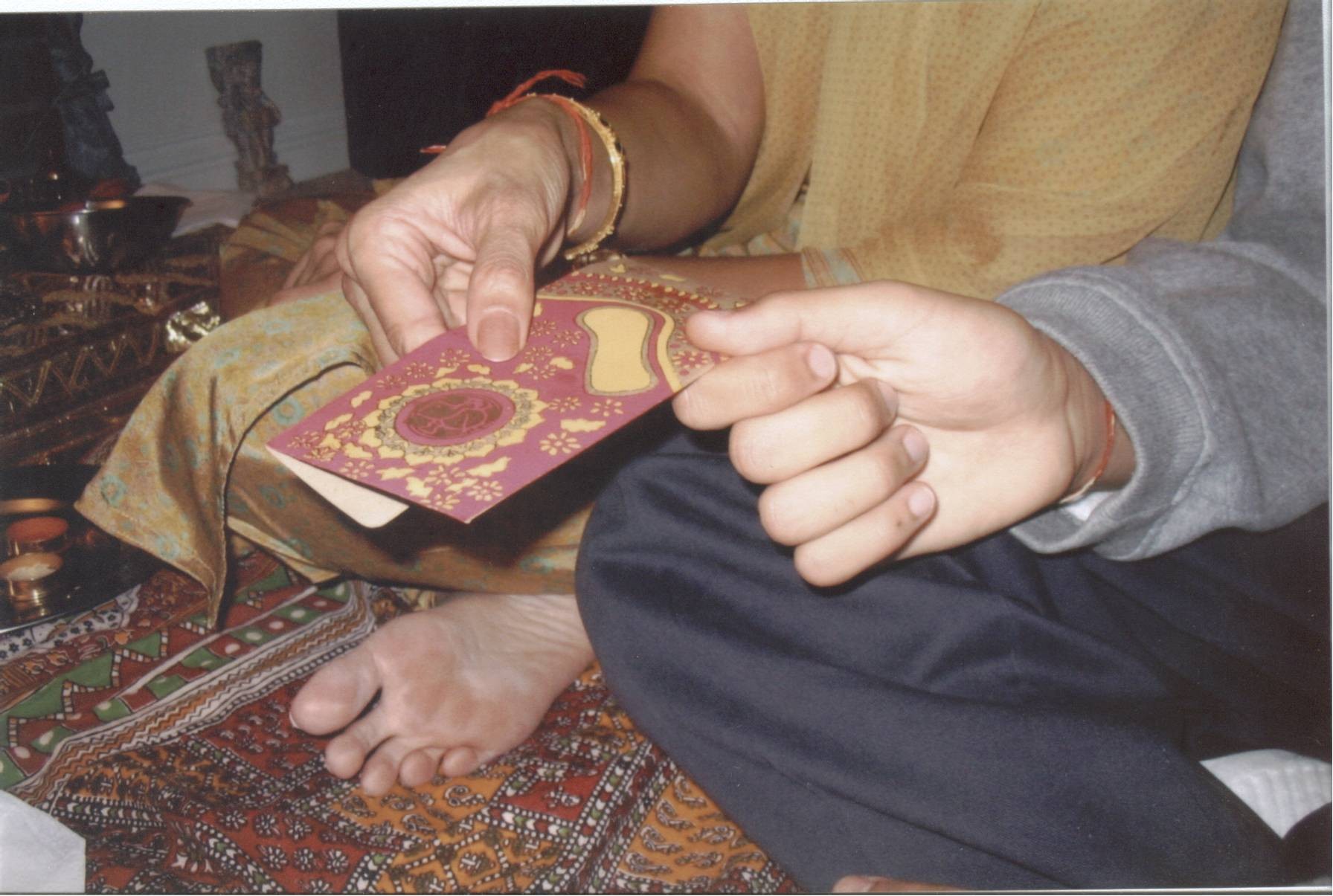|
The
Non-Monetary Uses of Money in Hinduism
Parul
Aggarwal, Cassandra Stewart, Taryn Pollack, Christine Young
Throughout time, diverse rituals and traditions have evolved
in numerous religions and cultures throughout the world. This paper will
address non-traditional forms that money takes on in various regions of
India with a concentration on the Indian state of Punjab, which is located
in the North. In Hinduism, the celebration of the New Year (Diwali) and
parts of the wedding ceremony demonstrate non-monetary uses of money within
a culture. The diversity in India has led to many different traditions
being associated with Diwali, and has spawned different meanings and reasons
for performing those same rituals and customs. The practice of praying
to business related items, gambling on Diwali, worshipping coins, and
the story of the goddess of wealth (Lakshmi) demonstrates the different
ways money is looked at in Hinduism. The idea of praying to gods and goddesses
in the hopes of bringing wealth to a family on Diwali is balanced by the
idea that without knowledge the wealth is meaningless. While money is
necessary to live, knowledge is necessary to sustain life.
Representing an age-old culture and celebrated
throughout India, with many rituals and traditions attached to it, is
Diwali, the Hindu New Year. Diwali is known as the festival of lights,
where tradition maintains that lamps and lights are lit throughout the
house to keep the memory of Prince Ram’s return to his kingdom after
defeating the demon king Ravan, who had abducted his wife Sita. The heroic
deeds of Ram, Sita, and Lakshmaan are recounted in the Ramayan with Diwali
symbolizing the victory of virtue over vice. Another reason for putting
lights around the house on Diwali is to light the way for Lakshmi, the
goddess of wealth. It is believed that she visits the houses of her devotees
and bestows luck and good fortune where she chooses. There are hundred’s
of rituals and traditions associated with Diwali, depending on which region
you are from. This is due to small amounts of regional variation that
can alter the way people practice and believe in certain traditions.
In many Punjabi (north India) families, it is believed that the time to
enter into new financial deals, buy tools of your trade, and start new
ledgers is on Deshara, which comes before Diwali. Deshara is the day that
Prince Ram defeated the demon king Ravan, and thus this is the day that
starts the “auspicious period”, which lasts until Diwali.
The time between Deshara and Diwali is the time that it took for Prince
Ram to return home, with Diwali being the day he returns to his kingdom,
where people had put lights around their house to light his way home.
On Deshara, business’s wipe their ledgers clean and start a new
ledger after performing a prayer, because it is believed that it is a
fresh start and all the bad luck that a business might have been experiencing
for the past year is now erased. Since this time of year is also considered
an “auspicious period”, one will have good luck with customers
and finance as well. Along with ledgers, business implements such as scissors
for a tailor or scales for a goldsmith, are also prayed to because it
is believed that if the tools of your respective trade are blessed, they
will bring you fortune and wealth. In a sense, the people are praying
for prosperity and wealth in their business and financial dealings.
In other northern parts of India, it is believed that instead of one,
there are five days of Diwali known as Dhantrayodashi (Dhanteras), Narakchaturdashi
(Kali Chaudas), Diwali (Laxmi Pujan), Bali Pratipada (Govardhan Pooja)
and Bhaubij (Bhaiya Dooj). The festivities begin with Dhanteras, which
is the busiest day for the merchant community since it is considered an
auspicious day for business. This is the day many people buy an idol of
Lakshmi to worship. People also buy gold or silver jewelry, or at least
one-kitchen utensil. It is believed that the purchase of a metal object
on this day is an auspicious token and that the particular item will reap
rewards that coordinate to it’s purpose. For example, if a person
wears the piece of jewelry they bought on Dhanteras then they will have
good luck in whatever they try, while on the other hand the kitchen utensil
will ensure that there is always plenty of food in the kitchen. On the
third day of the festival (Diwali) some communities worship their account
books for the upcoming year, unlike Punjabi families, who practice this
on Deshara. In south India, instead of praying to account books, many
farmers adorn and worship cattle because they produce the main source
of their income and are believed to the be the incarnation of Lakshmi.
The fourth day of the festival (Vikram Samvat) holds a special significance
for the merchant community. Normally, share markets are closed for the
holidays but a special session is held on this day called a muhurat session
because it is considered an auspicious day for share trading.
An unusual custom, which characterizes the festival of Diwali, is gambling,
especially in north India. It is believed on this night, the Goddess Parvati
played dice with her husband and enjoyed it so much that she decreed that
whoever gambled on Diwali night would prosper throughout the coming year.
Today, dice games have become obsolete in India and have been replaced
by card games such as flush, rummy, and gin. In today’s society,
the wealthy organize games involving thousands of rupees in clubs, hotels,
and private farmhouses, but the majority of people just play at home.
In Punjabi families, it is considered a vice to gamble during the year,
but is considered to be acceptable on Diwali. They believe that if you
win, when gambling on Diwali you will win all year round and will have
wealth in your favor. Some Punjabi families also believe that if a person
does not gamble on Diwali, then in their next life they will be reincarnated
as a donkey. This is considered to be very unpleasant since the donkey
is the animal who carries heavy loads on his back throughout his life.
On the other hand, some people claim to gamble on Diwali in order to remind
themselves of the fickleness of lady luck (Lakshmi), and to create a sense
of balance in the pursuit of material success. In ancient India, dice
games were very popular and Diwali might have been a time where farmers
could relax and spend time with family and friends, by playing dice games
and betting money that they had just acquired from the end of the harvest
season. This may be the actual social origin of the unusual practice of
gambling at Diwali, which now has acquired a divine sanction of recognition.
Gambling may have come into practice because when families are supposed
to keep their door open all night in order to welcome Lakshmi into the
house, someone was needed to keep guard all night. In order to keep from
falling asleep, people played cards or dice. In many parts of Gujarat,
the entire Hindu month of Shravan (usually in August-September) is considered
auspicious for gambling, instead of just Diwali.
Another custom that is practiced in India at Diwali time is the worshipping
of silver coins during prayer. At nighttime, a prayer is performed and
various objects are set alongside statues of the various God’s and
Goddess’s. Silver coins with pictures of Lakshmi and Ganesh are
set in silver trays and prayed to just as they were statues. Lakshmi is
prayed to because as the goddess of wealth, it is hoped that she will
bestow the home with good fortune and prosperity. While Ganesh, is prayed
to because he is the God that will remove all obstacles. He will remove
any obstacles that might prevent any type of work from being unsuccessful,
such as business ventures or job interviews. Silver is used instead of
gold because it is accessible and was also used as currency in India.
Up till the 1900’s, gold coins in bags were prayed to also, but
only by kings and big business families, not by the general public. Many
business families also place cash registers or boxes where they store
their money next to the statues and pray to them in hopes of protecting
their earned wealth. In some Punjabi families, a replica of the house
(handi) is also placed alongside the statues. The handi is always the
same shape and has openings where people can place food and money, indicating
that the house will always be filled with food and wealth. It is also
traditional to exchange gifts and money within the family. Whenever money
is given to a family member, it is an odd number and usually is a number
that will have “1” added to it. For example, the given amount
will be 21 or 31 or 41, but not 27 or 45 or 63. It is not exactly known
why this is so, but it is considered bad luck to give only evenly numbered
bills.
Diwali is also known as Lakshmipujan, which translates to “the worship
of Lakshmi.” Lakshmi’s story and the way she is portrayed
illustrate the way wealth is viewed in Hinduism. She holds the promise
of material fulfillment and contentment, but is seen as being fickle,
which is considered to be the nature of wealth. She is the goddess of
wealth and represents the goal of worldly, as well as spiritual, prosperity.
Being the wife of Lord Vishnu, she provides him with wealth for the maintenance
and preservation of all creation. Lakshmi is depicted as having four arms
and four hands, and standing on a lotus. One of the hands symbolizes wealth
and is depicted with golden coins falling out of it, meaning that she
provides wealth and prosperity to her devotees. The lotus that she stands
on signifies that while living in this world, one should enjoy wealth
but not become obsessed with it. This is analogous to the lotus, which
grows and thrives in water but is not immersed in it. Some pictures show
two elephants standing close by, symbolizing the recognition and respect
associated with worldly wealth. However, the idea is that a true follower
should not earn wealth merely to acquire fame or to satisfy material desires,
but should share it with mankind in order to bring happiness to others
as well as themselves. The owl is her vehicle and since the owl cannot
be seen in the day, Lakshmi visits the houses of her devotees at night.
The owl symbolizes black money and the immoral uses of money. Since the
owl is an animal that can see in the dark, it can detect “black-money”,
which is money that has not been put into the service of mankind and has
instead been squandered on corrupt deeds. This way, Lakshmi can navigate
her way towards such money and punish the people responsible for using
it. The creation of Lakshmi begins with her first being created as Shreedevi,
who nurtures and fills the earth with life and bounty. Both the Gods and
the demons desire her wealth and a war is waged from which the demon king
Bali emerges triumphant. Impressed by his strength, Shreedevi crowns him
king of the Earth and agrees to be with him. However, Bali grew arrogant
and felt that he owned everything on earth, which disturbed her greatly.
The Gods, who had been reduced to poverty, devised a plan in which they
retook control of the earth. One of the Gods’s approached Bali and
asked him for some land. To mock him, Bali replied that he would give
him as much land as a dwarf could cover in three strides. The chosen dwarf
was actually the incarnation of Lord Vishnu who in three strides covered
the whole earth and claimed it for the Gods. Shreedevi, impressed by the
God’s intelligence, decided to go to them, demonstrating her fickle
nature in which she is faithful to no one. However, Shreedevi’s
gifts were neglected by the Gods as well, and she leaves them. In the
end, she is reincarnated as Lakshmi and chooses Vishnu to be her husband,
as he is the only one who is not interested in the power, pleasure, and
prosperity that money can bestow. Alongside with Lakshmi, Alaksmi is also
born who is old and ugly representing the hunger, greed and evil side
that money can bring out in people. Lakshmi’s story represents the
nature of wealth, which is fickle and favors only those who do not abuse
it. It can be said that in Hinduism, money is given a human quality by
designating it the power to be evil or good depending upon how it is used.
If it is not used properly, it will either “leave you” or
will lead Lakshmi to “punish you.” Thus one should enjoy their
wealth, but should not horde it and not help mankind.
Married women in India are known as the “Ghar Ki Lakshmi”
meaning “the house’s Lakshmi.” When a new bride enters
the family, she is considered lucky and is a symbol of Lakshmi herself.
This is because in Indian culture, it is women who run the house and not
the men. It is believed that the woman is the one who knows how to budget
the money and she is the one who will save some money for a rainy day.
It is said that men should only earn the money, because they are not “intelligent”
enough to run the household and will only spend the money in a wasteful
manner. The financial responsibilities and the control of money in a household
are represented by silver key chains that women wear in India. The key
chains will contain all the keys to the house along with the key to the
cabinet where all the money is kept and also to the food pantry. Whenever
anybody needs money they will have to go to her, since she is the only
one who can open the cabinet. Therefore, whoever has the key chain controls
the money and thus controls the house. This responsibility is never given
to men and it’s probably because of how women are seen as a representation
of the Goddess Lakshmi.
In Punjabi Hindu weddings, there are several ceremonies that involve non-monetary
uses of money. There are two examples that clearly illustrate non-conventional
uses of money. The first is called sar pher. In this practice, one person
holds bills in their hands and moves amongst the dancing guests and circles
their heads with the bills. This is done to ward off the evil eye of other
guests at the wedding who may be jealous of the happiness they see amongst
the dancers. After the dancing is finished, the bills are then gathered
and given to the poor or to the local temple so that it can be put towards
helping the community. Another practice, called Kangana, is done after
the wedding when the bride is at the groom’s house. In this game,
a tray or pot of water is mixed with milk and vermillion and then coins
are placed inside the vessel. The bride and groom have several tries to
find the coins, whoever finds them first is said to rule the household.
There are several other practices that foster a sense of community and
build relationships between members of different families that are united
by the marriage of a son or daughter. One of the practices is stealing
the groom’s shoes, which he leaves at the base of the altar before
the marriage ceremonies begin. The bride’s sisters, cousins, and
friends steal the shoes while the groom’s brothers, cousins, or
friends try to find them. Since the groom cannot leave the altar without
his shoes after the wedding ceremonies, he must pay the bride’s
family money in order to get them back. Often, the price of the shoes
is negotiated with the bride’s family trying to get as much money
as possible. If the price asked is too high the elders might step in and
put an end to it. This creates a bond between the new family members.
Another practice is called milni, and is when the bride’s side of
the family greets the groom’s side of the family, and money or gifts
are given. In this tradition, each family member from the bride’s
side meets their counterpart in the groom’s family. For example,
the bride’s uncle would only offer money or gifts to the groom’s
uncle. The gifts of money are given by the bride’s family to the
groom’s family in order to welcome them as members.
In conclusion, non-monetary uses of money are far reaching and can provide
a sense of community and foster relationships between different families
and individuals. For Hindus, Diwali is a time of celebration when business
wipe their slates clean and pray for good fortune in the year to come.
Diwali also fosters a sense of community amongst family and friends. It
is an occasion when disagreements are forgotten, old friendships are renewed,
new friendships are formed, and families get together to feast and play.
Practices such as praying to silver coins in the hopes that the goddess
Lakshmi will bring good fortune to the house in the New Year is a clear
example of a non-monetary use of money. However, the hope of gaining good
fortune is balanced by the belief that wealth with out knowledge is useless.
Hindu weddings also demonstrate some of the nontraditional ways that money
can be used by establishing new relationships and helping the newly united
family members get to know one another.
Non-Monetary
Uses of Money: An Addendum
While researching this subject, we thought that it might be interesting
to compare or contrast non-monetary uses of money between cultures. We
chose to investigate the Roman Catholic tradition of alms-giving when
lighting votive candles and praying for the intercession of God. However,
our research showed that in the eyes of practicing Catholics this practice
is not viewed as abnormal. While the practice of alms-giving when lighting
votive candles is not as prevalent in newer churches, it has not been
extinguished in older churches. A short summary of our findings is included
below.
Catholicism is the oldest Christian religion, with a long history in which
monetary practices have been intertwined with religious rites. One of
the clearest examples of this intertwined relationship is the practice
alms giving when praying for intercession (lighting of votive candles).
For Catholics, the image of the candle burning its life out before a statue
represents a person’s love for God and symbolizes that person’s
devotion to the Catholic faith. Most often votive candles are white representing
the pure body of Christ, the wick contained therein represents His Soul
and the flame symbolizes the unification of the Divine nature of the human
soul within the body of Christ. The flame consuming the wick also can
represent the loss of resistance to God in the soul. As the flame consumes
the rest of the candle the person that lit it has found a union with God.
While these images might indicate a harmonious union of faith with everyday
life, in actuality the candles that embody Christ himself cost money to
produce. It could be argued that the Catholic Church only asks for donations
to cover the cost of the votive candles used in intercession. However,
there is not a standard consensus about the price the faithful Catholic
should pay when asking for the intercession of God it can be assumed that
the amount given always exceeds the cost of production. Why then, do the
“faithful” give money in excess of the cost of production
if there is truly no charge for the intercession of God? Among the Catholics
that we interviewed, there was no real consensus about the practice of
almsgiving when asking for intercession. Most of the people that we interviewed
believed that the excess money that they had given in excess of the cost
of the candles supported the church’s missions within their parish
and abroad. Cynics seemed to believe that the Catholic Church is in the
business of selling salvation for profit. People with these cynical views
seem to think that the Catholic Church has an ideal “racket”
going. The Catholic Church is in the business of selling paradise in the
hereafter to its faithful devotees. Catholics give alms to their church
in the hopes of a better life in the hereafter, but there is never any
concrete evidence that a faithful Catholic has a better life after death
than a heathen. The only thing that holds this practice together is the
faith held by the believers that they will have a better life in the hereafter
if they are “good” Catholics than if they are not. Pre Vatican
II, votive candle alters were found in most Roman Catholic Churches. In
our post Vatican II world, this is no longer the case. In the Church’s
quest to “modernize” the Catholic faith, such seemingly old
and backward traditions have been largely removed or replaced by other
more cost efficient traditions. Often the votive candles were replaced
with electric versions which completely eliminated the symbolism of sacrifice
and union with God.
|
|
